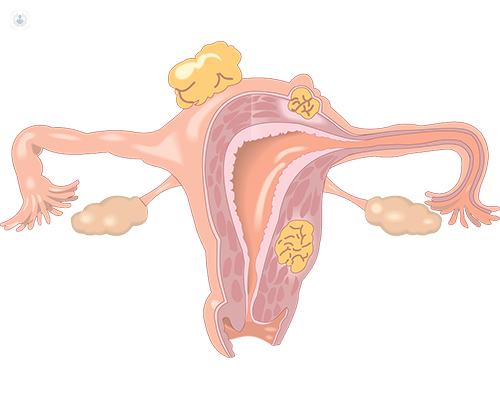Tratamientos para los miomas uterinos
Written by:Uterine fibroids are benign tumors that affect 70% of women up to 50 years of age; 25% are symptomatic, so most are asymptomatic and will not require treatment. *
There are evidences that associate the vascularization of the myoma to the potential of the growth, reason why patients with future gestation desires and very vascularized fibroids are raised if they treat this pathology in the thickness of the uterus (intramural) so that they do not grow and they interfere with the pregnancy.
Common Symptoms of Uterine Fibroids
- Long and painful menses
- Pressure, discomfort in the pelvis
- Pelvic pain, lumbar, rectal pressure
- Discomfort or pain during sexual intercourse
- Abortions
- Difficulty getting pregnant

Treatments for uterine fibroids
- Conventional treatments ; in the selection of treatment it is recommended that a gynecologist familiar with fibroids be made from the evaluation, especially in cases in which the patient's fertility or loss of the uterus are problems to be taken into account. Treatment of myoma should be from less invasive to more invasive.
- Medical treatment ; sometimes bleeding can be controlled with a contraceptive or a hormonal IUD, although these treatments correct bleeding but do not treat fibroids. Treatment with Ulipristal Acetate (Esmya 5 mg) is quite effective in reducing bleeding and pain, may reduce the size of myoma and may be guided in intermittent continuous mode. It should be used as a first choice in symptomatic fibroids.
- Minimally invasive treatments .
- Embolization of fibroids: this is a very effective method which, in principle, is not recommended in women who want pregnancy, because it implies pain the week after the procedure and a 15% risk of running out of regulation.
- HIFU: technique with wide trajectory that has demonstrated safety in patients who desire gestation. Ultrasound guided, performed from the outside. It is a treatment, with a non-invasive technique that is performed with superficial sedation (this technology is available in the clinic Santa Elena in Madrid and in Barcelona in Terrassa).
- Myomectomy; removal of myoma through laparoscopic surgery, hysteroscopy or open surgery. It has the disadvantages of surgery itself; The rate of recurrence of fibroids that are removed is 33%.
- Hysterectomy; is the complete extirpation of the uterus. This technique should be reserved for cases in which no other treatment is possible. Patients without uterus are up to 4 times more likely to have urinary incontinence and genital prolapses. The effect of hysterectomy on sexuality has not been sufficiently studied.

- Treatment with vaginal radiofrequency. Radiofrequency ablation is a minimally invasive treatment, alternative to surgery, which acts inside the fibroid thermocouple tissue through a very fine needle that, in a controlled way, emits radiofrequency throughout the surface of the myoma without damaging the muscle uterine. The fibroid will reduce its size and, in some cases, disappear by reabsorption.
The benefits of this technique are:
o Alternative to surgery
o No hospital admission required
o Avoid surgical risks
o Possibility of treating several fibroids in the same intervention
o Without aggression to the rest of the uterus, nor to the myometrium nor the endometrium (very important in women who wish to have children)
o Does not mean medical leave
o The patient can travel the same day of the intervention
o Rapid recovery of the patient
o Preserves fertility
Radiofrequency by vaginal route is done with sedation and with ultrasound-doppler control in 3D; the patient can go home in a few hours and will need mild analgesia for a few days.
* 1. Bu Ram Jr. You. Uterine Leiomyomata ae! Ology, symptomatology and management. Prog Clin Biol Res 1986; 225: 275-96.2. Okolo S. Incident, ae ology and epidemiology of uterine fibroids. Best Practicals and research clinical obstetrics and gynecology 2008; 22: 4; 571-88.


